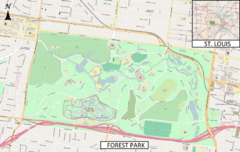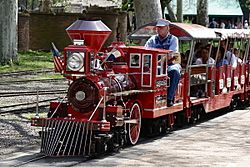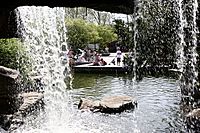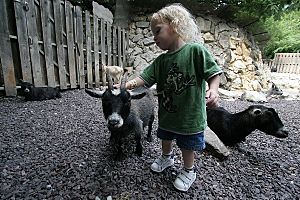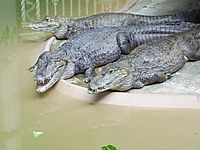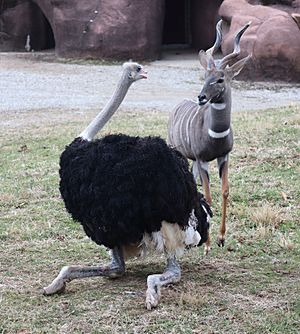Saint Louis Zoo facts for kids

Saint Louis Zoo logo
|
|

South entrance
|
|
| Date opened | 1910 |
|---|---|
| Location | Forest Park St. Louis, Missouri |
| Land area | 90 acres (36 ha) |
| Coordinates | 38°38′06″N 90°17′24″W / 38.635°N 90.290°W |
| No. of animals | 18,700 |
| No. of species | 603+ |
| Annual visitors | 3,000,000 (2016–17) |
| Memberships | AZA |
The Saint Louis Zoological Park (commonly known as the Saint Louis Zoo) is a zoo in Forest Park, St. Louis, Missouri. It is recognized as a leading zoo in animal management, research, conservation, and education. The zoo is accredited by the Association of Zoos and Aquariums (AZA). Admission is free based on a public subsidy from a cultural tax district, the Metropolitan Zoological Park and Museum District (ZMD); fees are charged for some special attractions. A special feature is the 2 ft (610 mm) narrow gauge Emerson Zooline Railroad with passenger trains pulled by Chance Rides C.P. Huntington locomotives that encircle the zoo, stopping at the more popular attractions.
The city purchased its first exhibit, the Flight Cage, from the Smithsonian Institution following the 1904 St. Louis World's Fair. After the zoo was established in 1910, new exhibits, areas and buildings were added through the decades to improve care of the animals, the range of animals and habitats shown, as well as education and interpretation. The head of the male lesser kudu, with his elegant spiraled horns, is the symbol of the Saint Louis Zoo.
In September 2017 the Saint Louis Zoo teamed up with the Missouri Botanical Garden and Washington University in St. Louis in a conservation effort known as the Living Earth Collaborative. The collaborative, run by Washington University scientist Jonathan Losos, seeks to promote further understanding of the ways humans can help to preserve the varied natural environments that allow plants, animals and microbes to survive and thrive. Some of their other ongoing conservation efforts include the #byetobags movement, encouraging the use of reusable bags, and their turtle tracking program which tracks location, population, and health of the box turtle population of Forest Park.
In 2017 and 2018, the zoo was chosen by USA Today as the best in the United States.
Contents
History
The early years
The 1904 St. Louis World's Fair is credited for the birth of the Saint Louis Zoo. The fair brought the world's attention to St. Louis and Forest Park. The Smithsonian Institution constructed a walk-through bird cage for the World's Fair. Ten days after the World's Fair closed, the citizens of St. Louis chose to buy the 1904 World's Fair Flight Cage for $3,500, rather than have it dismantled and returned to Washington, D.C. This was the first piece of what would become the Saint Louis Zoo.
By 1910, increased interest in a zoo brought together some concerned citizens, and they organized the Zoological Society of St. Louis. In 1914, it was incorporated as an independent civic organization of people interested in a zoo. Meanwhile, the citizens of St. Louis and surrounding municipalities expressed diverse opinions as to the appropriate location of a zoo if there should be one. Fairground Park, Carondolet Park, the Creve Coeur area, and Tower Grove Park were some of the places suggested in newspaper articles and letters to the editors and to civic groups. Some concerned citizens residing near Oakland Avenue, south of Forest Park, expressed their displeasure with a zoo in the park because of the smell of the animals. The zoo initially held 51 deer and antelope, 11 buffaloes, a sacred cow, a sandhill crane, 20 prairie dogs, a dromedary camel, eagles, ducks, elk, foxes, geese, swans, rabbits, a raccoon, a China sheep, opossums, a buzzard, owls, peafowl, among other animals. The head of the Parks Department, Dwight Davis, voiced his opinion against Forest Park—that is, until the city set aside 77 acres (31 ha) in the park in which to establish a zoological park. A five-man board was appointed to act as the Zoological Board of Control.
The number of board members was increased to nine in 1916, the same year the citizens voted to create a tax for the construction of the Saint Louis Zoo, with a 1/5 mill tax. It is said that this was the first zoo in the world which the citizens of a community supported by passing a mill tax.
1920 through 1969
Expansion of the zoo started in 1921 when the Bear Pits were built. The zoo continued to expand with construction of the Primate House in 1923 and the Reptile House in 1927.
The new Bird House was built in 1930. With the coming of the Great Depression, revenues were down and construction of new exhibits slowed at the zoo. In 1935, the Antelope House was built with the help of the Civil Works Administration (CWA), a program of President Franklin D. Roosevelt's New Deal. This burst of construction ended in 1939 with the addition of the Ape House. In 1939, the zoo acquired two giant pandas. Their names were Happy and Pao Pei. Happy died in 1945 and Pao Pei in 1952.
The Stupp Memorial Pheasantry and the lion arena, now the Sea Lion Arena, were built in 1954. Three years later, the Elephant House and its arena and moated yards were constructed.
Major construction started on the zoo again in 1971 when the Aquatic House was built. It continued with the opening of the Emerson Zooline Railroad in 1963, the Charles H. Yalem Children's Zoo, and the animal nursery in 1969.
1971 through present
In 1972, the zoo joined the Metropolitan Zoological Park and Museum District and began to receive revenue from a public property tax of 8 cents for every $100 assessed. This enabled continued improvements and upgrades of exhibit areas. Two major areas of the zoo, Big Cat Country and Jungle of the Apes, were constructed in 1976 and 1986, respectively.
In 1989, the Living World, a two-story building including classrooms, a reference library and teacher resource center, an auditorium, two exhibit halls emphasizing evolution and ecology, a large gift shop, a restaurant, and offices was built. It was designed by Hellmuth, Obata and Kassabaum.
In 1993, the zoo received a donation of the 355 acres (1.44 km2) Sears Lehmann farm, located west of St. Louis. It is to be used for the breeding of endangered species and for educational purposes.
In 1998, new areas were added with the Emerson Children's Zoo. Phase I of River's Edge, which opened in 1999, represented Asia: featuring Asian elephants, cheetahs, dwarf mongoose, and hyenas.
In 2000, the Monsanto Insectarium, now called the Bayer Insectarium, including the Butterfly House, was built. The North America (Missouri and Mississippi rivers) portion of River's Edge opened in 2001. In 2002, the third phase, featuring habitats of South America and Africa, opened with hippos, rhinos, warthogs, carmine bee-eaters, capybaras, and giant anteaters.
In 2003, the Penguin and Puffin Coast opened with both outdoor and indoor exhibits. Also new that year was the Mary Ann Lee Conservation Carousel, featuring unique hand-carved wooden animals representing endangered species at the Saint Louis Zoo. The Donn and Marilyn Lipton Fragile Forest opened in 2005. Caribbean Cove, which features stingrays, opened in 2008. In 2015, the zoo opened Polar Bear Point, a $16 million facility that includes different landscapes and exhibits about the polar bear's relationship with the Arctic ecosystem. Its first resident is named Kali, an orphaned polar bear donated to the zoo by the U.S. Fish and Wildlife Service.
The most recent update to the zoo is the addition of Centene Grizzly Ridge, an $11.1 million, 7,000 square foot state-of-the-art habitat that replaced the bear grottos built in 1921, which were used until 2015 when they were closed for the construction of Grizzly Ridge. Grizzly Ridge opened 15 September 2017 and is now home to two orphaned grizzlies from Montana. Huckleberry, or Huck, and his sister Finley were given to the zoo by the U.S. Fish and Wildlife Service. Grizzly Ridge is the culminating project of The Living Promise Campaign, a project started in 2010 that promised to raise $120 million in order to improve the zoo. By the end of the campaign in 2014, the zoo had exceeded this goal by $14 million, which funded not only Grizzly Ridge, but also Polar Bear Point, Sea Lion Sound (a new and improved way of viewing the sea lions, including a walk-through tunnel), and improvements to other areas of the zoo such as Peabody Hall and River's Edge, among others.
Beginning in 2013, the Saint Louis Zoo is undergoing a massive expansion of facilities and space for both visitors and staff. Most notable amongst this is a new development planned on 13.5 acres on the grounds of the former Forest Park Hospital, across Interstate 64 from the zoo campus. Once completed, the new facility will feature offices and classrooms, year-round exhibits, a mixed-use development that will link the complex with the adjacent Dogtown neighborhood, and an "iconic" connection of the two sites over Interstate 64. Most importantly, it will shift all parking to the hospital site, freeing up roughly nine acres currently used as a surface lot for additional exhibits.
Zoo directors
The following people have served as directors of the zoo:
- George P. Vierheller (1922–1962)
- R. Marlin Perkins (1962–1970), who gained fame for the zoo as host of Mutual of Omaha's Wild Kingdom
- William J. Hoff (1970–1973)
- Robert T. Briggs (1973–1975)
- Richard D. Schultz (1975–1982)
- Charles H. Hoessle (1982–2002)
- Dr. Jeffrey P. Bonner (2002–present)
Park zones
Lakeside Crossing
Open during the warmer months, Caribbean Cove is a shallow touch-pool underneath a large pavilion that features cownose rays, southern stingrays, bonnethead sharks, and bamboo sharks. It is one of the only parts of the zoo requiring an admission price, but is free during the first hour the zoo is open.
River's Edge
A variety of animals are represented from four continents in River's Edge. The South America exhibit displays spectacled bears, bush dogs, capybaras, giant anteaters, and scarlet macaws. The African Savanna displays black rhinoceros, African wild dogs, sacred ibises, bat-eared foxes, red river hogs, and a colony of southern carmine bee-eaters. The African Nile features hippopotamus, tilapia, cheetahs, spotted hyenas, and a colony of dwarf mongoose. The Asia exhibit features adult Asian elephants and sun bears. The North American exhibit displays fish and wildlife from the Missouri and Mississippi Rivers containing crayfish, American bullfrog, channel catfish, gar, and bluegill.
Discovery Corner
The St. Louis Children's Zoo has many educational features, such as the see-through slide through the otter pool and many birds, snakes, frogs, and other animals that volunteers and staff bring out for the kids to see up close. This is one of the only exhibits at the Zoo that requires an admittance fee; however admission is free for the first hour the zoo is open during the summer. As of March 2016, the zoo has Tasmanian devils in this section.
Most of the zoo's invertebrates are found in the Monsanto Insectarium. Represented species include leafcutter ant, flower mantis, Vietnamese walking stick, Atlas beetle, American burying beetle, sunburst diving beetle, water scorpion, brown widow spider, brown recluse spider, yellow garden spiders, Platymeris biguttatus, cobalt blue tarantula, Texas brown tarantula, and Egyptian fattail scorpion.
The Wild
The Wild is home to Grizzly Ridge, Polar Bear Point, Conservation Carousel, Fragile Forest, Jungle of the Apes, and Penguin and Puffin Coast. Polar Bear Point features a polar bear called Kali. Two grizzly bears named Huck and Finn arrived for the opening of Grizzly Ridge in 2017. The Fragile Forest and Jungle of the Apes features gorillas, chimpanzees and orangutans in a naturalized outdoor setting. Penguin and Puffin Coast displays a variety of water birds including Humboldt penguins,King penguins, rockhopper, gentoo penguins, horned puffins, tufted puffins, and king eiders. Individual habitats for red pandas and black-tailed prairie dogs are also in The Wild.
Historic Hill
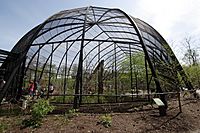
Historic Hill contains Bird House, Bird Garden, Sea Lion Sound, Herpetarium, Chain of Lakes, Flight Cage and Cypress Swamp, and Primate House. The Bird House features birds as varied as bald eagle, rhinoceros hornbill, hyacinth macaw, burrowing owl, toco toucan, Cape thick-knee, golden pheasant, kookaburra, Mariana fruit-dove, king vulture, horned guan, superb starling, tawny frogmouth, congo peafowl, and the Guam kingfisher, which is extinct in the wild. The Bird Garden contains outdoor bird enclosures. Sea Lion Sound provides an underwater viewing tunnel of California sea lions and three harbor seals. The herpetarium houses most of the zoo's reptiles and amphibians, including the critically endangered Jamaican iguana, Chinese alligator, McCord's box turtle, Panamanian golden frog, and Arakan forest turtle. Other species include the Komodo dragon, green anaconda, mountain chicken, spotted turtle, false gharial, king cobra, Gila monster, frill-necked lizard, Aldabra giant tortoise, tuatara, reticulated python, tiger salamander, three-toed amphiuma, pancake tortoise, and over two dozen species of pit vipers from around the world. The Chain of Lakes is a series of small enclosures between the Bird House and the Herpetarium and Primate House, where the zoo's North American river otters and alligator snapping turtles reside. In 1904, the Flight Cage was the largest bird cage ever built, and is still one of the world's largest free-flight aviaries at 228 feet (69 m) long, 84 feet (26 m) wide, and 50 feet (15 m) high. The Cypress Swamp is dedicated to North American birds found it the cypress swamps of the southern Mississippi River. Among the birds in the aviary are black-crowned night heron, blue-winged teal, bufflehead duck, cattle egret, double-crested cormorant, great egret, wood duck, northern bobwhite, roseate spoonbill, snowy egret, and American white ibis. Primate House is home to the zoo's monkeys and lemurs. Species included are Allen's swamp monkey, Coquerel's sifaka, golden-headed lion tamarin, black-and-white colobus monkey, lion-tailed macaque, pygmy marmoset, ring-tailed lemur, and white-faced saki.
Red Rocks
Big Cat Country is home to several species of big cats. The represented species are the African lion, Amur leopard, Amur tiger, jaguar, cougar, and snow leopard. At Antelope House the species present are the addax, babirusa, Banteng, Bactrian camel, gerenuk, Grevy's zebra, Indian muntjac, lesser kudu, okapi, reticulated giraffe, Somali wild ass, Speke's gazelle, Sichuan takin, gorals, Soemmerring's gazelle, Transcapsian urial, and Visayan warty pig. Non-ungulates found in the Red Rocks include the marsupials red kangaroo and tammar wallaby, as well as several birds in mixed-exhibits with the ungulates, such as the ostrich, Stanley crane, grey crowned crane, and Sarus Crane.
- Historical Photos
Images for kids
See also
 In Spanish: Parque Zoológico de San Luis para niños
In Spanish: Parque Zoológico de San Luis para niños


